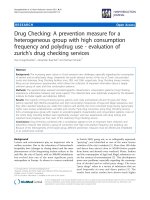Novel III v mosfet integrated with high k dielectric and metal gate for future CMOS technology
Bạn đang xem bản rút gọn của tài liệu. Xem và tải ngay bản đầy đủ của tài liệu tại đây (2.43 MB, 116 trang )
NOVEL III-V MOSFET INTEGRATED WITH HIGH-K
DIELECTRIC AND METAL GATE FOR FUTURE CMOS
TECHNOLOGY
JIANQIANG LIN
NATIONAL UNIVERSITY OF SINGAPORE
2009
NOVEL III-V MOSFET INTEGRATED WITH HIGH-K DIELECTRIC
AND METAL GATE FOR FUTURE CMOS TECHNOLOGY
Jianqiang
Lin
2009
NOVEL III-V MOSFET INTEGRATED WITH
HIGH-K DIELECTRIC AND METAL GATE FOR
FUTURE CMOS TECHNOLOGY
JIANQIANG LIN
(B. Eng, NUS)
DEPARTMENT OF ELECTRICAL AND COMPUTER
ENGINEERING
A THESIS SUBMITTED
FOR THE DEGREE OF MASTER OF ENGINEERING
NATIONAL UNIVERSITY OF SINGAPORE
2009
Acknowledgement
Acknowledgement
I wish to express my sincere appreciation to my advisor, Prof. Sungjoo Lee, for
giving me the opportunity to work in an interesting and rewarding field, and for his
support over the course of this project.
I would like to acknowledge Hoon-Jung Oh whose work is a critical
complementary to this thesis. My gratitude also goes to the other members of the
Silicon Nano Device Lab, Institute of Microelectronic, and Institute of Materials
Research and Engineering, who have provided important discussion and aid to my
work: Weifeng Yang, Hui Zang, Jian Wang, Rui Li, Fei Gao, Wai Linn O-Yan, Yu Fu
Yong, Patrick Tang, Boon Teck Lau and etc.
I would like to thank Prof. Yee-Chia Yeo, Prof. Ganesh Samudra, Prof. ChunHuat Heng and Dr. Kah-Wee Ang, who were the first teachers leading me to the path
of electron device research. My passion for this area has kept growing ever since.
My special recognition goes to Yuting Lin and Xueyan Huang, who have provided
me critical help to continue my pursuit.
Finally, I would like to thank my parents. They always support me to pursue my
dream with everything they can do. Their support has encouraged my endeavor even
in the most difficult moments in this journey.
THE AUTHOR
I
Table of Contents
Table of Contents
Acknowledgement ..........................................................................................................I
Table of Contents .......................................................................................................... II
Summary ....................................................................................................................... V
List of Figures ............................................................................................................ VII
List of Tables ............................................................................................................ XIV
List of Abbreviations ................................................................................................. XV
Chapter 1 : Introduction ................................................................................................. 1
1.1
Background ..................................................................................................... 1
1.2
Challenge and Motivation ............................................................................... 2
1.2.1
Technology trends .................................................................................... 2
1.2.2
Performance boosters ............................................................................... 4
1.3
Objective ......................................................................................................... 8
1.4
Outline of the Thesis ..................................................................................... 11
1.5
Reference ....................................................................................................... 12
Chapter 2 : Fabrication of InGaAs MOSFET .............................................................. 19
2.1
Introduction ................................................................................................... 19
2.2
Growth of Substrate ...................................................................................... 19
2.3
Directly Deposited High-k on III-V .............................................................. 23
2.3.1
Surface preparation ................................................................................ 23
2.3.2
High-k/InGaAs interface study .............................................................. 24
2.3.3
Band alignment ...................................................................................... 27
2.3.4
MOS capacitor ....................................................................................... 28
II
Table of Contents
2.4
Source and Drain Activation ......................................................................... 30
2.5
MOSFET with Directly Deposited HfAlO.................................................... 34
2.5.1
Process integration ................................................................................. 34
2.5.2
Results and discussion ........................................................................... 36
2.6
Summary ....................................................................................................... 39
2.7
Reference ....................................................................................................... 42
Chapter 3 : Interface Engineering of InGaAs MOSFET ............................................. 46
3.1
Introduction ................................................................................................... 46
3.2
Process Integration ........................................................................................ 47
3.3
Results and Discussion .................................................................................. 48
3.3.1
Interface study ........................................................................................ 48
3.3.2
Plasma PH3 passivated InGaAs MOS capacitor .................................... 54
3.3.3
Plasma PH3 passivated InGaAs MOSFET ............................................. 57
3.3.4
Comparison with other III-V MOS systems .......................................... 63
3.4
Summary ....................................................................................................... 65
3.5
Reference ....................................................................................................... 65
Chapter 4 : Scaling of InGaAs MOSFET ................................................................... 68
4.1
Introduction ................................................................................................... 68
4.2
Nano-sized Structure ..................................................................................... 69
4.2.1
Process design ........................................................................................ 69
4.2.2
Selection of hard mask material ............................................................. 70
4.2.3
Pattern transfer ....................................................................................... 73
4.3
Source and Drain Consideration ................................................................... 74
4.4
Process Integration ........................................................................................ 75
III
Table of Contents
4.5
Modified Approach - Dual Gate Mask Process ............................................ 78
4.6
Summary ....................................................................................................... 83
4.7
Reference ....................................................................................................... 83
Chapter 5 : Conclusion................................................................................................. 85
5.1
Summary of This Work ................................................................................. 85
5.1.1
Modular process and transistor integration ............................................ 85
5.1.2
Interface engineering ............................................................................. 86
5.1.3
Short channel MOSFET ......................................................................... 87
5.1.4
Summary ................................................................................................ 87
5.2
Future Work .................................................................................................. 88
5.2.1
Advanced interface engineering ............................................................ 88
5.2.2
Reduction in parasitic elements ............................................................. 88
5.2.3
Novel device structures .......................................................................... 89
Appendix 1 : Mask Catalog ......................................................................................... 91
Appendix 2 : List of Publications ................................................................................ 94
Appendix 3 : List of Awards ........................................................................................ 97
IV
Summary
Summary
This project has developed the process to fabricate novel III-V MOSFET. The
main process steps include pre-gate cleaning, CVD high-k gate dielectric deposition,
gate electrode deposition and etching, selective source and drain implantation, dopant
activation and contact formation.
The Silicon implantation is used to form n+ source and drain. Contact resistance,
sheet resistance and junction characteristic are studied. RTA temperature and time are
calibrated. It is found that InGaAs enables a relatively low temperature for activation.
The CVD HfAlO and HfO2 gate dielectrics are directly deposited onto the InGaAs
after pre-gate cleaning. It is found that InGaAs, with high Indium concentration, has
better integration compared to GaAs. With sputtered TaN metal gate electrode, the
MOS capacitor is studied. The MOSFET is then fabricated by an implanted source
and drain selectively self-aligned to the gate.
Next, interface engineering with the plasma PH3 passivation is introduced to the
MOSFET fabrication. Detail analysis by XPS shows the chemical composition on the
surface after PH3 treatment. Passivation results in the improvement of surface quality
and helps in the InGaAs integration with high-k dielectric. Transistor performance has
a significant enhancement. Two important figures of merit, on-state current and
subthreshold swing, are compared with the directly deposited control devices.
Electron mobility is extracted by a split C-V method.
With the advantage of self-alignment, scaling of the MOSFET becomes much
easier. The short channel InGaAs MOSFET is fabricated by a novel approach. The
gate is patterned by Electron Beam Lithography and Platinum hard mask. It is
V
Summary
demonstrated that 40 nm gate line can be achieved by this method, and high
performance for small channel length MOSFET is reported.
As the platform for further study, the limitation of current device and process are
discussed. This yields further research on topics including source and drain
engineering, material and fabrication compatibility, novel device investigation and so
on.
VI
List of Figures
List of Figures
Fig. 1.1 : Schematic of a typical bulk MOSFET structure. Four terminals are denoted
as Gate (G), Source (S), Drain (D), and Body (B). Geometry parameters are denoted
as gate length (L) and gate width (w). The current flows from drain to source. ............ 2
Fig. 1.2 : Historical trend agrees with the Moore’s Law. Number of transistor in the
Intel Micro Processor increases exponentially over time. It has reached 1 billion in the
Dual Core Itanium processor by year 2007. (Source: Intel) .......................................... 3
Fig. 1.3 : Expected intrinsic delay requirement versus future years. To achieve sub 0.1
ps performance in year 2019, alternative channel materials such as Ge and III-V are
expected to be necessary. (Source: 2007 ITRS Winter Public Conf.) ........................... 8
Fig. 1.4 : A schematic showing a possible combination of technology boosters. In the
front end, device has high-k dielectric, metal gate electrode, thin body, high mobility
InGaAs for n-FET and Ge for p-FET. The back end interconnect includes low-k
dielectric and low resistive metal Cu. [1.26] ................................................................. 8
Fig. 2.1 : AFM images of surface topology for MBE grown samples. The scanning
areas are 5x5 um2. The surface RMS roughness values are indicated for each sample.
(a) 15 nm undoped In0.15Ga0.85As growth on p-GaAs. substrate (b) 30 nm undoped
In0.53Ga0.47As on p-InP. (c) 30 nm Be doped In0.53Ga0.47As on p-InP. ........................ 20
Fig. 2.2 : Specification for MBE growth of p-InGaAs on InP. An InP buffer is first
grown, followed by InGaAs. InGaAs is 500 nm thick, lattice matched with InP. ...... 21
Fig. 2.3 : Doping concentration as function of depth from the InGaAs surface in Type1 substrate. Near the surface dopant concentration is about 1x1017 cm-3. ................... 23
Fig. 2.4 : AFM image of InGaAs of (a) as growth, RMS roughness is 0.74 nm; (b)
after pre-gate cleaning and surface treatment RMS roughness is 0.82 nm. Scanning
window is 5x5 um2....................................................................................................... 24
VII
List of Figures
Fig. 2.5 : InGaAs showing a better suppression of As-O formation comparing to GaAs.
After pre-gate cleaning and exposed to atmospheric ambient, the XPS scan of As-3d
peak is shown. A clear As-O formation is found in GaAs sample and it is not detected
on InGaAs. ................................................................................................................... 25
Fig. 2.6 : InGaAs showing a better suppression of As-O formation comparing to GaAs.
After a thin layer (2 nm) of HfAlO deposition and PDA, high resolution XPS scan of
the Oxygen 1s-peak shows clear native oxide of As and Ga on the GaAs sample,
while such native oxide components are not detectable on InGaAs sample. .............. 26
Fig. 2.7 : Valence band spectra of p-InGaAs bulk and HfO2 film deposited on pInGaAs. ........................................................................................................................ 27
Fig. 2.8 : VB spectra method determined band offset for HfAlO and HfO2 on InGaAs.
...................................................................................................................................... 28
Fig. 2.9 : Normalized capacitance for two MOS systems (a) TaN/HfAlO/p-InGaAs
and (b) TaN/HfAlO/p-GaAs. Hysteresis is 0.4 V for InGaAs substrate for and 1.1 V
for GaAs substrate. Indium reduces the hysteresis significantly. ................................ 29
Fig. 2.10 : TLM test structure. Number n (0, 1, 2…) denotes the contact number. dn
denotes the distances between two adjacent contact pad. Z is the width of the contact.
...................................................................................................................................... 31
Fig. 2.11 : Total resistance versus distance. TLM test results for implanted samples
which are activated at different conditions. Two linear fitting parameters are slope and
intercept with the y axis. .............................................................................................. 31
Fig. 2.12 : Sheet resistance in various activation condition, measured by both fourpoint probe and TLM method. ..................................................................................... 32
Fig. 2.13 : Junction current versus the voltage across n+/p junction applied between
the implanted source/drain and the substrate in InGaAs n-MOSFET. ........................ 33
VIII
List of Figures
Fig. 2.14 : Process flow of fabricating InGaAs n-MOSFET. Process steps (a-f) are
described by a cross sectional schematic diagram in next figure. ............................... 34
Fig. 2.15 : Cross sectional schematic of self-aligned InGaAs MOSFET fabrication. (a)
– (e) are the intermediate steps and (f) is the final device structure. ........................... 35
Fig. 2.16 : Top view of a ring-shape gate InGaAs MOSFET. This transistor is
fabricated with a two-mask step. ................................................................................. 36
Fig. 2.17 : A cross section of an inversion-mode self-aligned In0.53Ga0.47As nMOSFET with CVD HfAlO gate dielectric and TaN metal gate. ............................... 37
Fig. 2.18 : The gate leakage current density versus the voltage applied to the gate with
source, drain and backside electrode grounded for the fabricated InGaAs n-MOSFET.
...................................................................................................................................... 37
Fig. 2.19 : Inversion capacitance versus applied gate bias. Inversion capacitance
measures the high frequency capacitance (100 kHz) between gate to source and drain
with substrate grounded as shown in the inset schematic. ........................................... 38
Fig. 2.20 : Log scale Id-Vg of In0.53Ga0.47As n-MOSFET of 4 m gate length showing
the subthreshold performance. ..................................................................................... 40
Fig. 2.21 : Linear scale Id-Vg of In0.53Ga0.47As n-MOSFET and gate transconductance
versus gate bias with 50 mV and 1 V drain bias. ......................................................... 41
Fig. 2.22 : Id-Vd of In0.53Ga0.47As n-MOSFET of 4 m gate length in a bidirectional
drain bias sweeping for hysteresis study ...................................................................... 41
Fig. 3.1 : TEM images of the gate stacks by (a) HfO2 direct deposition; (b) Plasma
PH3-passivation and HfO2. Conformal high-k film, interface and substrate are seen for
both cases. About 1 nm thick passivation layer is observed in plasma PH3-passivation
sample. ......................................................................................................................... 49
IX
List of Figures
Fig. 3.2 : AFM image of the (a) InGaAs after pre-gate cleaning, (b) plasma PH3passivated InGaAs surface. The RMS roughness values for (a) and (b) are 0.682 nm
and 0.312 nm, respectively. The scan windows are 5x5 m2. ..................................... 50
Fig. 3.3 : XPS study of the InGaAs surfaces plasma-PH3-passivated sample detects
the (a) P-2p peak and (b) N-1s peak. Both disappear after a sputtering of 5 cycles,
equivalent to about 2 nm, confirming a very shallow surface incorporation of
Phosphors with little in-diffusion. The PxNy forms a chemically stable compound
which passivates the surface and smoothen the surface. ............................................. 51
Fig. 3.4 : (a) As-3d peak on the non-passivated and (b) passivated InGaAs surface
after exposed to atmospheric ambient for a sufficient long time. Thermally unstable
Arsenic Oxide is found formed on unpassivated surface, while passivation suppresses
its formation. In the first case, the decomposited Arsenic Oxide peak shows a major
composition of As2O3. ................................................................................................. 53
Fig. 3.5 : Capacitance-Voltage (C-V) characteristic at 1 kHz of plasma PH3 passivated
MOS capacitor with TaN/HfO2/InGaAs gate stack. Simulation of ideal C-V
characteristic is the Circled line. A close match between the simulated and measured
curve indicates a high-quality MOS capacitor. Physical thickness for HfO2 is 10 nm.
...................................................................................................................................... 55
Fig. 3.6 : Capacitance-Voltage (C-V) characteristic at 1 kHz of plasma PH3 passivated
MOS capacitor with TaN/HfAlO/InGaAs gate stack. Simulation of ideal C-V with
fitting parameters is the circled line. Physical thickness for HfAlO is 5.5 nm. ........... 55
Fig. 3.7 : Gage leakage density of direct deposition (open circle) and passivated
(solid rectangle) HfO2/InGaAs MOS capacitors. Similar leakage levels are observed.
...................................................................................................................................... 56
Fig. 3.8 : Gate leakage comparison with other MOS gate stack structures. ................ 56
X
List of Figures
Fig. 3.9 : Plasma PH3 passivated MOSFET inversion capacitance versus applied gate
bias from 500 Hz to 1 MHz. It has low frequency dispersion, indicating low interface
traps in a wide range of frequencies and successful channel formation. ..................... 58
Fig. 3.10 : The hysteresis of inversion capacitance at 10 KHz from -0.5 V to 2 V
measuring range. Inversion capacitance measures between gate to source and drain
with substrate grounded, shown in the inset. ............................................................... 58
Fig. 3.11 : Drain current at the subthreshold region. Log scale Id-Vg of InGaAs nMOSFET of 4 m gate length with 50 mV and 1 V drain bias for passivated
MOSFET (solid) and directly deposited control (dash-dot). ....................................... 59
Fig. 3.12 : Id-Vd of HfO2/InGaAs MOSFET for (a) without (b) with PH3-passivation.
...................................................................................................................................... 60
Fig. 3.13 : Id-Vg characteristics and corresponding transconductances for passivated
InGaAs n-MOSFET with 4 m gate length at drain bias of 0.05 V and 1 V. ............. 61
Fig. 3.14 : Drain current hysteresis for a bi-directional sweeping of gate voltage from
-1 V to 1.5 V at drain bias of 1 V................................................................................. 62
Fig. 3.15 : Channel electron mobility versus effective electric field extracted from an
InGaAs n-MOSFET of 4 m gate length by the split C-V method. ............................ 62
Fig. 3.16 : The subthreshold swing comparison of passivated InGaAs n-MOSFET
(triangle) with direct deposition (square) over a temperature from 300 K to 400 K.
The scale bars indicate the maximum and minimum S.S. values and solid symbols
indicate the mean value of all measured devices. ........................................................ 63
Fig. 3.17 : On-current versus gate length comparison under similar gate overdrive in
n-MOSFET with passivated and directly deposited InGaAs n-MOSFET. A significant
increase in drive current is obtained with the interface engineering on HfO2/InGaAs
gate stack. ..................................................................................................................... 64
XI
List of Figures
Fig. 4.1 : Fabrication of gate feature of very fine line width. (a) Gate stack (b) Spin
coat of PMMA resist (c) EBL drawing and developed pattern (d) Hard mask
deposition by E-beam evaporation (e) Lift off (f) RIE etching. .................................. 71
Fig. 4.2 : SEM images after RIE etching of TaN using 10 nm thickness Ni as hard
mask. (a) low magnification image (b) high magnification image. The line is not
straight.......................................................................................................................... 72
Fig. 4.3 : 50 nm thickness Ni as hard mask after RIE etching. (a) low magnification
SEM image. A shadow is shown at the edge of the pattern. (b) AFM image of 2x2
m2 window. (c) Surface profile height versus distance x across the line in image (b).
The shadow areas are the non-removed material. ........................................................ 72
Fig. 4.4 : 10 nm thickness Pt as hard mask after RIE etching. (a) low magnification
SEM image. (b) high magnification SEM image shows the line width is 128 nm. (c)
AFM image of 2x2 m2 window. (d) Surface profile height versus distance x across
the line in image (c). Clear and straight line is observed. ............................................ 73
Fig. 4.5 : 10 nm Pt hard mask is used to fabricate MOS structure. The TEM cross
section of gate length of 49 nm and 40 nm are shown in (a) and (b) respectively.
Straight edge with aspect ratio of 2.5:1 is obtained. .................................................... 74
Fig. 4.6 : MC simulation of as implanted dopant distribution profile as a function of
depth. Implant dose is 1x1014 cm-2. ............................................................................. 75
Fig. 4.7 : Process integration of short channel InGaAs MOSFET. Yellow bullet
indicates the step different from long channel transistor fabrication. .......................... 76
Fig. 4.8 : TEM image of cross section of InGaAs MOSFET with directly-deposited
HfO2 gate dielectric, Pt hard mask defined 95 nm TaN gate, self-aligned S/D
implantation. ................................................................................................................ 77
Fig. 4.9. Id-Vg and Id-Vd characteristics of 95 nm gate length InGaAs MOSFET
directly-deposited HfO2 gate dielectric in (a) and (b) respectively. ............................ 77
XII
List of Figures
Fig. 4.10 : Short channel InGaAs MOSFET fabricated by the modified dual gate
mask approach. The Electron Beam Lithography (EBL) and Photo Lithography (PL)
defined areas are shown. .............................................................................................. 79
Fig. 4.11 : Inversion C-V characteristic for InGaAs MOSFET with plasma PH3
passivation for Type-2 substrate. ................................................................................. 80
Fig. 4.12 : Id-Vg characteristic of long channel (17 m) device is illustrated. The
MOSFET is with plasma PH3 passivation for Type-2 substrate. ................................. 81
Fig. 4.13 : Id-Vg and transconductance of 600 nm gate length InGaAs MOSFET on
Type-2 substrate with plasma PH3 passivation. ........................................................... 82
Fig. 4.14 : Id-Vd of 600 nm gate length InGaAs MOSFET on Type-2 substrate with
plasma PH3 passivation. ............................................................................................... 82
Fig. A.1 : Layout for plastic mask “JEROME NOV08”. Five regions are denoted in
different color and serve different function. Including the GATE mask (yellow),
CONTACT mask (blue), TLM mask (red), MESA mask (green) and SPARE mask
(grey). ........................................................................................................................... 92
Fig. A.2 : (a) 4-die gate mask and (b) 4-die contact mask pattern. .............................. 93
Fig. A.3 : (a) TLM isolation and (b) TLM contact pattern. ......................................... 93
XIII
List of Tables
List of Tables
Table 1.1 : ITRS 2007, from the Process, Integration, Devices and Structures (PIDS)
report. It indicates the industry requirement for certain technology node in future. As
seen, most of technology solution to reaches 32 nm node in 2013 is still unknown
[1.5]. ............................................................................................................................... 4
Table 1.2 : Common semiconductor materials properties, including electron and hole
mobility, lattice parameter and bandgap. Ge has high electron and hole mobility over
Si. III-V compounds usually have high electron mobility. But they also have larger
lattice constant, resulting in significant lattice mismatch with Silicon. ......................... 7
Table 2.1 : Two types of substrate and their specifications. Type-1 substrate is the
main source of study in this work. Type-2 substrate has a lower doping level and
exactly orientated surface which is available for the more recent study. .................... 22
XIV
List of Abbreviations
List of Abbreviations
ALD
Atomic Layer Deposition
AZ5214
One Type of Positive Photoresist
CBO
Conduction Band Offset
C-V
Capacitance-Voltage
CVD
Chemical Vapor Deposition
DIBL
Drain Induced Barrier Lowering
EBL
Electron Beam Lithography
ECV
Electrochemical Capacitance-Voltage
EDS
Electron Dispersion Spectroscopy
EOT
Equivalent Oxide Thickness
FET
Field Effect Transistor
FUSI
Fully Silicide
GWP
Gross World Product
HEMT
High Electron Mobility Transistor
IC
Integrated Circuit
InGaAs
Indium Gallium Arsenide (In this work, Indium is 53% if not
mentioned otherwise)
IPL
Interfacial Passivation Layer
ITRS
International Technology Roadmap for Semiconductors
MBE
Molecular Beam Epitaxial
MOCVD
Metalorganic Chemical Vapor Deposition
MOSFET
Metal Oxide Semiconductor Field Effect Transistor
PDA
Post-Deposition Anneal
XV
List of Abbreviations
PMMA
Poly-methyl-methacrylate
RIE
Reactive Ion Etching
RTA
Rapid Thermal Annealing
SCE
Short Channel Effect
SEM
Scanning Electron Microscopy
TEM
Transmission Electron Microscopy
VBO
Valence Band Offset
XRD
X-Ray Diffraction
XPS
X-ray Photoelectron Spectroscopy
XVI
Chapter 1: Introduction
Chapter 1 : Introduction
1.1 Background
Since the first semiconductor transistor was invented by Bardeen, Brattain and
Shockley in 1947 and the first IC (Integrated Circuits) was demonstrated on
Germanium by Kilby in 1958, the semiconductor industry has gone through an
evaluation at an incommensurable speed for half a century. At present, semiconductor
technology is the foundation of many modern civilizations. It forms the basis of the
rapid growth of the global electronic industry which is now the largest industry in the
world. It is predicted that the semiconductor and electronic industry will continue to
extend its proportion in the Gross World Product (GWP). By year 2030, the
semiconductor industry may reach 1.6 trillion dollars, while the entire electronic
industry may reach 10 trillions dollars and constitutes 10% of the GWP [1.1].
All IC chips, from microprocessor to microcontroller circuit, are made of various
small units, i.e. the electron device. Nowadays, the number of transistors integrated in
a single IC chip has been increased to billions, and it is usually denoted as the ULSI
era. One of the most important electron devices is the MOSFET (Metal Oxide
Semiconductor Field Effect Transistor). Currently, the MOSFET is the main stream
device for VLSI or ULSI application. From the advance in MOSFET technology, the
state-of-art VLSI or ULSI design can provide many diverse benefits, such as, ultrafast computation, multiple functionality, low standby power and operating power, etc.
From super computing machine such as the IBM Blue Gene, to consumer product
such as the i-Pod (one of the popular personal portable electronics) and MEMS gyro
circuitry in automobile vehicle (the second largest industry in the world), human
civilization greatly benefits from the advance of the powerful IC and MOSFET.
1
Chapter 1: Introduction
G
Dielectric
D
L
w
S
B
Fig. 1.1 : Schematic of a typical bulk MOSFET structure. Four terminals are denoted
as Gate (G), Source (S), Drain (D), and Body (B). Geometry parameters are denoted
as gate length (L) and gate width (w). The current flows from drain to source.
The MOSFET is a three- or four-terminal device. The four-terminal bulk
MOSFET is shown in Fig. 1.1. The saturated drain current is given by Equation 1.1,
where C is the inversion capacitance, (Vg-Vth) is the gate overdrive, eff is the effective
carrier mobility.
Id
weff C
2L
(Vg Vth ) 2
(1.1)
1.2 Challenge and Motivation
1.2.1 Technology trends
As explained, the revolution of MOSFET technology has been the heart of the IC
industry. Scaling of the complementary MOSFET is the driving forces for the
increasing IC speed and functionality. Such scaling is vividly described by Moore’s
law [1.2][1.1]. It was proposed in the 1960s by Gordon Moore, the co-founder of Intel
Corporation, that for every 18 months, the size of the transistor will reduce by two
2
Chapter 1: Introduction
times and the density of devices in a chip will double. The historical trend obeys this
exponential scaling law closely as shown in Fig. 1.2.
Year
Fig. 1.2 : Historical trend agrees with the Moore’s Law. Number of transistor in the
Intel Micro Processor increases exponentially over time. It has reached 1 billion in the
Dual Core Itanium processor by year 2007. (Source: Intel)
As Moore himself stated in year 2003 [1.4] – No exponential is forever: but
“forever” can be delayed. However, there will be increasing challenges of continuing
the trend when scaling approaches smaller scale. It requires innovation in both
material and device engineering. The international technology roadmap for
semiconductors (ITRS), drafted by the world’s major semiconductor industry
associations, is an assessment of the semiconductor industry’s future technology
requirements. According to this roadmap, and in actual fabrication, the industry is
now moving towards 45 nm technology node. Table 1.1 is extracted from the 2007
ITRS high performance logic requirement [1.5]. To continue the movement to the
next generation, such as the 32 nm technology node, most of the technology solutions
3
Chapter 1: Introduction
required to achieve the expected performance are still not known. To tackle those
technological challenges, research of advanced MOSFET becomes extremely
imperative.
Table 1.1 : ITRS 2007, from the Process, Integration, Devices and Structures (PIDS)
report. It indicates the industry requirement for certain technology node in future. As
seen, most of technology solution to reaches 32 nm node in 2013 is still unknown
[1.5].
1.2.2 Performance boosters
Along with scaling, various technology boosters, such as high-k dielectric, metal
or FUSI gate electrode and the transport-enhanced channel, are necessary to control
short channel effect (SCE) and maintain continuous performance enhancement.
4
Chapter 1: Introduction
Silicon dioxide (SiO2) has been an ideal material as a gate dielectric for Silicon
based MOSFET for several decades. However, to control SCE in extremely small
devices, the roadmap requires an equivalent oxide thickness below 1 nm. It is not
practical to continue using SiO2 because the gate leakage density will become
intolerable for thin oxides. High-k dielectric enables the scaling of equivalent oxide
thickness (EOT) with a realistic dielectric physical thickness. There has been a long
history of research for high-k dielectric used in silicon MOSFET and such gate
dielectric materials will be introduced in industry fabrication very soon [1.6].
Conventional poly Silicon gate suffers from the poly depletion effect. This
increases the EOT and compromise the gate to channel electrostatic coupling.
Increasing the doping can minimize the poly depletion effect but Boron penetration
will occur and cost threshold voltage instability problem. This can be solved by
replacing the poly gate by metal or Fully Silicide (FUSI) gate. And the metal gate will
be introduced along with high-k dielectric to form the next generation of transistor
gate stack [1.9].
In current CMOS technology, the Ion/Ioff ratio is a commonly evaluated merit. It
has direct impact on the static power consumption which is critical to Low Standby
Power (LSTP) applications. However the subthreshold current for the conventional
CMOS device is mainly attributed to the source carrier diffusion current. So the Ion/Ioff
ratio is painfully constrained by the limit of 60 mV/dec subthreshold swing (S.S.).
This has led to the quest for a switching device having sharper S.S. to achieve a better
Ion/Ioff ratio. Innovative device concepts have been proposed for such a purpose. The
impact-ionization MOS transistor is one example [1.12].
Strained-Silicon channel has been proven to be useful to improve the saturation
drain current in situation where the inversion carrier mobility is serious degraded by
5
Chapter 1: Introduction
heavy doping in the vicinity of the channel and the use of high-k dielectric. StrainedSilicon has already been successfully integrated into the industrial fabrication process
to enhance channel mobility and IC performance. This is a result of great research
interests in strain engineering in Silicon, such as, the adoption of multiple processstrained Silicon technique [1.15], high stress Silicon-nitride etch-stop liner [1.16],
stress memorization technique [1.17] and the combination of source/drain stressors
and strain-transfer structure [1.18]. However, aggressive gate pitch scaling for the
purpose of higher circuit density results in the diminished performance gain from
various strain engineering schemes. Performance gain degradation associated with
stress loss due to pitch scaling will be considerable when the technology generation
progresses from the 45 nm node to the 32 nm node [1.20]. As the manufacture of IC
devices approaches the 32 nm technology node, researches for future devices that has
diminishing dimension in conventional Silicon MOSFET structure are facing many
obstacles. To tackle those problems, it calls for the exploration of new materials and
device structures to extend the Silicon CMOS scaling.
In deep submicron devices, the thermal injection of carriers from the source into
the channel poses a limit for the maximum saturated drain current. This can be
overcome by incorporating a more efficient carrier injecting material [1.21].
Considerable interest has been directed towards channel engineering using materials
with lower effective mass and high intrinsic carrier mobility, such as Germanium and
III-V compounds. The properties of several semiconductor materials are shown in
Table 1.2 [1.22].
Germanium has a high mobility for electrons and holes. The Germanium pMOSFET has been studied extensively [1.23]. However, there are a lot of difficulties
in fabricating Germanium n-MOSFET. On the other hand, several types of III-V
6









